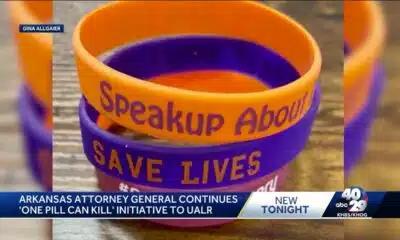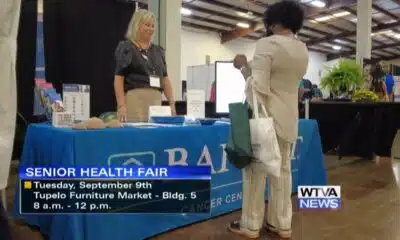Kaiser Health News
Epidemic: What Good Is a Vaccine When There Is No Rice?
Tue, 24 Oct 2023 09:00:00 +0000
The 1970s was the deadliest decade in the “entire history of Bangladesh,” said environmental historian Iftekhar Iqbal. A deadly cyclone, a bloody liberation war, and famine triggered waves of migration. As people moved throughout the country, smallpox spread with them.
In Episode 7 of “Eradicating Smallpox,” Shohrab, a man who was displaced by the 1970 Bhola cyclone, shares his story. After fleeing the storm, he and his family settled in a makeshift community in Dhaka known as the Bhola basti. Smallpox was circulating there, but the deadly virus was not top of mind for Shohrab. “I wasn’t thinking about that. I was more focused on issues like where would I work, what would I eat,” he said in Bengali.
When people’s basic needs — like food and housing — aren’t met, it’s harder to reach public health goals, said Bangladeshi smallpox eradication worker Shahidul Haq Khan.
He encountered that obstacle frequently as he traveled from community to community in southern Bangladesh.
He said people asked him: “There’s no rice in people’s stomachs, so what is a vaccine going to do?”
To conclude this episode, host Céline Gounder speaks with Sam Tsemberis, president and CEO of Pathways Housing First Institute.
He said when public health meets people’s basic needs first, it gives them the best shot at health.
The Host:
Céline Gounder
Senior Fellow & Editor-at-Large for Public Health, KFF Health News
Céline is senior fellow and editor-at-large for public health with KFF Health News. She is an infectious diseases physician and epidemiologist. She was an assistant commissioner of health in New York City. Between 1998 and 2012, she studied tuberculosis and HIV in South Africa, Lesotho, Malawi, Ethiopia, and Brazil. Gounder also served on the Biden-Harris Transition COVID-19 Advisory Board.
In Conversation With Céline Gounder:
Sam Tsemberis
Founder, president, and CEO of Pathways Housing First Institute
Voices From the Episode:
Shohrab
Resident of the Bhola basti in Dhaka
Iftekhar Iqbal
Associate professor of history at the Universiti Brunei Darussalam
Shahidul Haq Khan
Former World Health Organization smallpox eradication program worker in Bangladesh
Click to open the transcript
Transcript: What Good Is a Vaccine When There Is No Rice?
Podcast Transcript
Epidemic: “Eradicating Smallpox”
Season 2, Episode 7: What Good Is a Vaccine When There Is No Rice?
Air date: Oct 24, 2023
Editor’s note: If you are able, we encourage you to listen to the audio of “Epidemic,” which includes emotion and emphasis not found in the transcript. This transcript, generated using transcription software, has been edited for style and clarity. Please use the transcript as a tool but check the corresponding audio before quoting the podcast.
[Ambient sounds from a ferry play softly.]
Céline Gounder: I’m on a boat in southern Bangladesh, headed toward Bhola, the country’s largest island.
We’re traveling by ferry on calm waters. But my head spins — and my stomach roils just a bit — as I imagine how these same waters nearly destroyed Bhola Island.
[Tense instrumental music begins playing.]
It was 1970.
In November, under an almost-full moon and unusually high tides.
The island was hit by one of the most destructive tropical storms in modern history: the Bhola cyclone.
[Shohrab speaking in Bengali fades under English translation.]
Shohrab: There were floods. Back then there weren’t any embankments to stop the water from rising.
Céline Gounder: Counterclockwise winds, torrential rains, and treacherous waves swept entire villages into the sea. People held onto whatever they could to keep their heads above water.
[Shohrab speaking in Bengali fades under English translation.]
Shohrab: I remember at that time the water level rose so high that people ended up on top of trees. The water had so much force. Many people died.
Céline Gounder: The Bhola cyclone killed some 300,000 people. And for those who survived, there wasn’t much left to return to. Hundreds of thousands of people lost their homes, their farms, and their access to food.
The man whose voice you’ve been hearing was one of the survivors.
[Shohrab speaking in Bengali fades under English translation.]
Shohrab: My name is Shohrab. I am 70 years old.
Céline Gounder: Shohrab was a teenager when the cyclone hit. And in the days and weeks after the storm, he and his family joined a mass migration of people who fled southern Bangladesh.
They traveled about a hundred miles north from Bhola Island to the streets of Dhaka, the busy capital of Bangladesh.
There, they settled in a makeshift community, a kind of unsanctioned encampment dubbed the Bhola basti.
In Bengali that word,“basti,” means settlement — or “slum,” in some translations.
The residents forged a community, but soon, the poor people there — and what they built — would be seen as a threat to the effort to keep smallpox in check.
Not just in South Asia — but around the world.
I’m Dr. Céline Gounder. This is “Epidemic.”
[“Epidemic” theme music plays.]
[Ambient sounds from the Bhola basti, including voices of people speaking Bengali, play softly.]
Céline Gounder: More than 50 years after the cyclone, Shohrab lives in the same area in Dhaka.
I interviewed him at a tea stall near his home. It’s the kind of place where men gather to gossip and share stories over hot drinks.
Inside there’s a colorful display of snacks and sweets hanging from the ceiling. Just outside we sat on well-worn wooden benches.
And as we sip our tea, he tells me about life in the encampment in the 1970s …
[Sparse music plays softly.]
[Shohrab speaking in Bengali fades under English translation.]
Shohrab: I used to rent a place there. Five or six of us used to live in one room. Sometimes it was eight people in a room.
Céline Gounder: To cover his portion of the rent he worked as a day laborer, doing odd jobs here and there. Over time the basti became home.
But Shohrab’s new home was likely seen as an eyesore by outsiders — and by the Bangladeshi government.
Such settlements often lack running water, or electricity, or access to proper sanitation. Those conditions spotlight suffering — and for local leaders that spotlight can be uncomfortable.
But, public health experts had a different concern: that the settlement of Bhola migrants in Dhaka would become a deadly stronghold for smallopox. Cramped and unsanitary living conditions put the residents at high risk.
I ask Shohrab if he remembers seeing or hearing about people with smallpox when he first arrived.
[Shohrab speaking in Bengali fades under English translation.]
Shohrab: I wasn’t thinking about that. I was more focused on issues like where would I work, what would I eat, etc.
Céline Gounder: As he tried to rebuild his life, other things — like food and shelter — were more urgent.
[Music fades to silence.]
Widening beyond that one migrant encampment in Dhaka, researchers say the picture was similar in cities and villages all across the country.
Bangladesh was hit with a series of crises. Environmental historian Iftekhar Iqbal says each brought human suffering — and that each was a blow to the smallpox eradication effort.
Iftekhar Iqbal: Seventies was really a time when, the coming of the smallpox couldn’t come at a, at a more unfortunate time.
Céline Gounder: In 1970 the Bhola cyclone hit. In 1971, just four months later, the country fought a bloody liberation war. Then, in 1974, heavy rain and flooding triggered a famine. And in 1975 there was a military coup.
Iftekhar Iqbal: The 1970s was the deadliest decade in the history of Bangladesh.
Céline Gounder: This period is when the country became Bangladesh — winning its independence from Pakistan in the liberation war. But residents of the young nation faced cascading upheaval and turmoil. And too much death.
[Instrumental music plays softly.]
On the global stage stopping smallpox was important, but many in Bangladesh were just trying to make it to the next day.
Daniel Tarantola: No. 1 priority is food and food and food. And the second priority is food and food and food.
This was an area where survival was always in question.
Céline Gounder: That’s Daniel Tarantola.
He’s from France and arrived in the region with the mission of helping to eradicate smallpox, but he says the people in front of him needed help with many other things.
Besides hunger, some of the villages he visited were dealing with two epidemics: smallpox and cholera.
Daniel Tarantola: And we were not equipped to do anything but smallpox containment and smallpox eradication. By design or by necessity, we didn’t have the means to do anything much more than that.
Céline Gounder: Over the course of this season we’ve talked about big, complicated issues — like stigma and bias, distrust, or First World arrogance — that threatened to derail the smallpox eradication campaign. We’ve documented the public health workers who found a way around those roadblocks.
But sometimes the need is so big, so entrenched, that your inability to meet it can be demoralizing. I sometimes felt that during my own fieldwork: battling HIV and tuberculosis in Brazil and southern Africa, and during an Ebola outbreak in Guinea, West Africa.
Daniel Tarantola says in South Asia the best he could do was focus on the task at hand.
Daniel Tarantola: Meaning that you had to set up a program to eradicate smallpox or at least eliminate it from Bangladesh and at the same time not get … if I can use the word distracted, um, by other issues that prevailed in Bangladesh.
[Music fades out.]
Céline Gounder: Those were tough emotional realities for health workers and the people they wanted to care for.
But …
Daniel Tarantola: The level of resilience of this population is absolutely incredible given the number of challenges that they have had to survive.
Céline Gounder: One of the main ways people survived the upheaval in Bangladesh was by picking up and moving away from the things trying to kill them.
Remember how Shohrab fled to Dhaka after the cyclone?
Well, mass migration is a survival strategy — but one that can worsen disease.
When the cyclone refugees from Bhola landed in that under-resourced basti in Dhaka, all smallpox needed was an opportunity to spread.
[Solemn music begins playing.]
That opportunity came in 1975 when the Bangladeshi government decided to bulldoze the Bhola basti.
Daniel Tarantola says it was a bad idea.
Daniel Tarantola: We knew there was smallpox transmission in this particular area and therefore they should wait until the outbreak subsides before dismantling the shanties.
Céline Gounder: Government officials did not wait for the outbreak to subside. They bulldozed the basti anyway.
Daniel Tarantola: That resulted in a wide spread of smallpox.
Céline Gounder: Here’s environmental historian Iftekhar Iqbal again.
Iftekhar Iqbal: This eviction is considered one of the policy errors that led to the second wave of postwar smallpox.
Céline Gounder: In the wake of that eviction in 1975, thousands of people scattered. Some surely returned back home to Bhola.
[Music fades out.]
Céline Gounder: Public health’s failure — the government’s failure — to meet the basic need for safety, for food and housing, delayed the goal to stop the virus.
Shahidul Haq Khan, the Bangladeshi public health worker and granddad we met in Episode 4, says he learned that lesson over and over as he urged people to accept the smallpox vaccination.
Their frustration with him — and by extension public health — was clear.
[Shahidul speaking in Bengali fades under English translation.]
Shahidul Haq Khan: There was no rice in people’s stomachs, so what is a vaccine going to do? “You couldn’t bring rice? Why did you bring all this stuff?” That was the type of situation we had to deal with.
[Atmospheric music begins playing.]
Céline Gounder: What good is a vaccine when there is no rice?
Next up, I speak with Sam Tsemberis, founder of Pathways Housing First Institute. It’s an organization that advocates for meeting people’s basic needs first, so they’ll have the best shot at health.
But in the beginning, he found out convincing institutions was easier said than done:
Sam Tsemberis: I try to explain this rationale that I’m telling you, like people need housing first and then services. The hospital is like, “No, no, we’re in the hospital business. We’re not in the housing business.”
Céline Gounder: That’s after the break.
[Music fades to silence.]
Céline Gounder: One of my mentors was Dr. Paul Farmer, the legendary doctor and anthropologist whose work in Haiti was documented by Tracy Kidder in the book “Mountains Beyond Mountains.” Paul always pushed us to look beyond the symptoms to root causes. It’s a lesson we keep having to learn in public health again and again.
Sam Tsemberis is one of the first to apply it to homelessness. He’s the CEO of a nonprofit called the Pathways Housing First Institute. The organization promotes a model of addressing homelessness that begins with putting people into housing.
That idea seems pretty obvious. But back when Sam first started working on homelessness — in New York City in the 1980s — the prevailing model was more like a staircase. People had to work their way up to show they were ready for, or even worthy of, housing.
Sam Tsemberis: If you showed up applying for housing, you had to acknowledge you had a mental illness, you had to demonstrate that you were taking medication, and that you understood why you were taking medication. And you also had to have — if you had any history of alcohol or substance use, you also had to demonstrate a period of sobriety.
It was a very tough regimen to get into housing.
Céline Gounder: Sam said he quickly realized that wasn’t working, even though it was the only approach at the time.
Sam Tsemberis: I was working very hard to help people navigate that. I was doing street outreach. So, “Come come to the shelter, come to the hospital, come to a treatment program, a drop-in center,” hoping that they would engage and successfully make it up the stairs and get housing eventually.
And what began to emerge was that even if people were willing to take the first step — let’s say go to detox or go to the hospital — far too many people ended up returning to the street, which was, which was a signal that, you know, something was wrong with this system. It’s like, why are people falling back?
And the stories on the street were compelling. You know, people would say, “No, I don’t need to go to detox. What I need is a safe place to stay.”
Or, “Yeah, I’ve been diagnosed with schizophrenia, but … you know, and I still hear voices, but I don’t pay attention to them. Right now, I’m just cold, I’m tired, I’m hungry, I need a place to be safe. I need to go inside. That’s what I need first.”
And the repeated pleas for safety, security, a place to call home, from people that had tried and failed and tried and failed that staircase system is what compelled me to, you know, try something different, because what we were doing wasn’t working. And that’s when we started this housing-first approach.
Céline Gounder: Can you explain: What is that, and what’s its impact?
Sam Tsemberis: Housing-first is the answer to a question that we ask people. “OK, what is it that you want?” And people would inevitably say, “I want a place to live, isn’t it obvious?”
So our job as providers, then, was to figure out a way to have a program that we can get money for rent, and money for case management services, and give people who had previously no opportunity to get into housing on their own terms, and also offer the kind of clinical or social or emotional support that’s needed after people get housed.
Céline Gounder: So how did you pilot or how did you jump-start this effort? What did that look like?
Sam Tsemberis: So we ended up having to start our own nonprofit agency, apply for a grant, and we, with fingers crossed, we started to take people that were actively using and in some cases actively symptomatic and put them into apartments of their own and visit them a lot, not knowing how it would turn out.
What we found, much to our shock and surprise, very pleasant surprise, is that 85% of the people we housed, even in that first year, remained housed. And we thought, well, you know, we’re onto something here.
Céline Gounder: So instead of insisting that people be treated for addiction and mental health issues before they got into housing, you gave them housing first. And that was really sort of the measure of success.
Sam Tsemberis: Yes.
Céline Gounder: How successful was the program in treating addiction and mental health?
Sam Tsemberis: The addiction and mental health treatment outcomes were modestly better for the housing-first group that didn’t require to be in treatment. But you know, their treatment was no worse and a little better than the group that required treatment and sobriety.
And there, a measure called the overall quality of life, you know, like, how happy are you with living in the community, with your contacts with relatives, and so on. The group that went into housing first had a significantly higher quality of life than the treatment-first group.
Céline Gounder: So I know there are people out there who will say, Well, you didn’t solve their addiction issue or their mental health issue; how is that a success? How would you respond to that criticism?
Sam Tsemberis: This was never advertised as a program that cures addiction or cures mental illness. Recovery, in some ways, is not abstinence. Recovery, at least in the mental health business, is having a life in spite of your diagnosis.
The main thing is you’re no longer homeless. You know, you don’t have to be on the street until you’ve cured your illness. Because if that was the case, people would likely die on the street before they cured their illness because we don’t have cures for some of these illnesses.
Céline Gounder: So, Sam, Dr. Paul Farmer was a mentor of mine, actually, over the course of my training. And in Tracy Kidder’s biography of Paul, there’s a quote of one of Paul’s colleagues, Haitian colleagues, who says that, “Giving people medicine for tuberculosis and not giving them food is like washing your hands and drying them in the dirt.”
Sam Tsemberis: That is so on target for what all of these issues are about. I think of homelessness, actually, as a poorly named term for all of the systemic failures that people have faced in order to end up homeless.
We need to get, you know, take care of the emergency, put everyone in housing, but that’s sort of the beginning of the job. Then the real work starts to address the root causes that contribute and continue to increase the problem as opposed to just dealing with the symptom all the time.
[“Epidemic” theme music begins playing.]
Céline Gounder: Next time, on the series finale of “Epidemic: Eradicating Smallpox” …
Rahima Banu.
Redwan Ahmed: Rahima Banu.
Daniel Tarantola: Rahima Banu.
Iftekhar Iqbal: Rahima Banu.
Larry Brilliant: The last case …
Steve Jones: The last case …
Alan Schnur: The last case of variola major smallpox. I think this time we’ve got it.
Céline Gounder: “Eradicating Smallpox,” our latest season of “Epidemic,” is a co-production of KFF Health News and Just Human Productions.
Additional support provided by the Sloan Foundation.
This episode was produced by Taylor Cook, Zach Dyer, Bram Sable-Smith, and me.
Saidu Tejan-Thomas Jr. was scriptwriter for the episode.
Redwan Ahmed was our translator and local reporting partner in Bangladesh.
Our managing editor is Taunya English.
Oona Tempest is our graphics and photo editor.
The show was engineered by Justin Gerrish.
We had extra editing help from Simone Popperl.
Voice acting by Susheel C. and Pinaki Kar.
Music in this episode is from the Blue Dot Sessions and Soundstripe.
We’re powered and distributed by Simplecast.
If you enjoyed the show, please tell a friend. And leave us a review on Apple Podcasts. It helps more people find the show.
Follow KFF Health News on X (formerly known as Twitter), Instagram, and TikTok.
And find me on X @celinegounder. On our socials, there’s more about the ideas we’re exploring on our podcasts.
And subscribe to our newsletters at kffhealthnews.org so you’ll never miss what’s new and important in American health care, health policy, and public health news.
I’m Dr. Céline Gounder. Thanks for listening to “Epidemic.”
[“Epidemic” theme fades out.]
Credits
Taunya English
Managing Editor
Taunya is senior editor for broadcast innovation with KFF Health News, where she leads enterprise audio projects.
Zach Dyer
Senior Producer
Zach is senior producer for audio with KFF Health News, where he supervises all levels of podcast production.
Taylor Cook
Associate Producer
Taylor is associate audio producer for Season 2 of Epidemic. She researches, writes, and fact-checks scripts for the podcast.
Oona Tempest
Photo Editing, Design, Logo Art
Oona is a digital producer and illustrator with KFF Health News. She researched, sourced, and curated the images for the season.
Additional Newsroom Support
Lydia Zuraw, digital producer Tarena Lofton, audience engagement producer Hannah Norman, visual producer and visual reporter Simone Popperl, broadcast editor Chaseedaw Giles, social media manager Mary Agnes Carey, partnerships editor Damon Darlin, executive editor Terry Byrne, copy chief Chris Lee, senior communications officer
Additional Reporting Support
Swagata Yadavar, translator and local reporting partner in IndiaRedwan Ahmed, translator and local reporting partner in Bangladesh
Epidemic is a co-production of KFF Health News and Just Human Productions.
To hear other KFF Health News podcasts, click here. Subscribe to Epidemic on Apple Podcasts, Spotify, Google, Pocket Casts, or wherever you listen to podcasts.
KFF Health News is a national newsroom that produces in-depth journalism about health issues and is one of the core operating programs at KFF—an independent source of health policy research, polling, and journalism. Learn more about KFF.
USE OUR CONTENT
This story can be republished for free (details).
——————————
Title: Epidemic: What Good Is a Vaccine When There Is No Rice?
Sourced From: kffhealthnews.org/news/podcast/epidemic-season-2-episode-7-what-good-is-a-vaccine/
Published Date: Tue, 24 Oct 2023 09:00:00 +0000
Did you miss our previous article…
https://www.biloxinewsevents.com/quick-genetic-test-offers-hope-for-sick-undiagnosed-kids-but-few-insurers-offer-to-pay/
Kaiser Health News
How To Find the Right Medical Rehab Services
Rehabilitation therapy can be a godsend after hospitalization for a stroke, a fall, an accident, a joint replacement, a severe burn, or a spinal cord injury, among other conditions. Physical, occupational, and speech therapy are offered in a variety of settings, including at hospitals, nursing homes, clinics, and at home. It’s crucial to identify a high-quality, safe option with professionals experienced in treating your condition.
What kinds of rehab therapy might I need?
Physical therapy helps patients improve their strength, stability, and movement and reduce pain, usually through targeted exercises. Some physical therapists specialize in neurological, cardiovascular, or orthopedic issues. There are also geriatric and pediatric specialists. Occupational therapy focuses on specific activities (referred to as “occupations”), often ones that require fine motor skills, like brushing teeth, cutting food with a knife, and getting dressed. Speech and language therapy help people communicate. Some patients may need respiratory therapy if they have trouble breathing or need to be weaned from a ventilator.
Will insurance cover rehab?
Medicare, health insurers, workers’ compensation, and Medicaid plans in some states cover rehab therapy, but plans may refuse to pay for certain settings and may limit the amount of therapy you receive. Some insurers may require preauthorization, and some may terminate coverage if you’re not improving. Private insurers often place annual limits on outpatient therapy. Traditional Medicare is generally the least restrictive, while private Medicare Advantage plans may monitor progress closely and limit where patients can obtain therapy.
Should I seek inpatient rehabilitation?
Patients who still need nursing or a doctor’s care but can tolerate three hours of therapy five days a week may qualify for admission to a specialized rehab hospital or to a unit within a general hospital. Patients usually need at least two of the main types of rehab therapy: physical, occupational, or speech. Stays average around 12 days.
How do I choose?
Look for a place that is skilled in treating people with your diagnosis; many inpatient hospitals list specialties on their websites. People with complex or severe medical conditions may want a rehab hospital connected to an academic medical center at the vanguard of new treatments, even if it’s a plane ride away.
“You’ll see youngish patients with these life-changing, fairly catastrophic injuries,” like spinal cord damage, travel to another state for treatment, said Cheri Blauwet, chief medical officer of Spaulding Rehabilitation in Boston, one of 15 hospitals the federal government has praised for cutting-edge work.
But there are advantages in selecting a hospital close to family and friends who can help after you are discharged. Therapists can help train at-home caregivers.
How do I find rehab hospitals?
The discharge planner or caseworker at the acute care hospital should provide options. You can search for inpatient rehabilitation facilities by location or name through Medicare’s Care Compare website. There you can see how many patients the rehab hospital has treated with your condition — the more the better. You can search by specialty through the American Medical Rehabilitation Providers Association, a trade group that lists its members.
Find out what specialized technologies a hospital has, like driving simulators — a car or truck that enable a patient to practice getting in and out of a vehicle — or a kitchen table with utensils to practice making a meal.
How can I be confident a rehab hospital is reliable?
It’s not easy: Medicare doesn’t analyze staffing levels or post on its website results of safety inspections as it does for nursing homes. You can ask your state public health agency or the hospital to provide inspection reports for the last three years. Such reports can be technical, but you should get the gist. If the report says an “immediate jeopardy” was called, that means inspectors identified safety problems that put patients in danger.
The rate of patients readmitted to a general hospital for a potentially preventable reason is a key safety measure. Overall, for-profit rehabs have higher readmission rates than nonprofits do, but there are some with lower readmission rates and some with higher ones. You may not have a nearby choice: There are fewer than 400 rehab hospitals, and most general hospitals don’t have a rehab unit.
You can find a hospital’s readmission rates under Care Compare’s quality section. Rates lower than the national average are better.
Another measure of quality is how often patients are functional enough to go home after finishing rehab rather than to a nursing home, hospital, or health care institution. That measure is called “discharge to community” and is listed under Care Compare’s quality section. Rates higher than the national average are better.
Look for reviews of the hospital on Yelp and other sites. Ask if the patient will see the same therapist most days or a rotating cast of characters. Ask if the therapists have board certifications earned after intensive training to treat a patient’s particular condition.
Visit if possible, and don’t look only at the rooms in the hospital where therapy exercises take place. Injuries often occur in the 21 hours when a patient is not in therapy, but in his or her room or another part of the building. Infections, falls, bedsores, and medication errors are risks. If possible, observe whether nurses promptly respond to call lights, seem overloaded with too many patients, or are apathetically playing on their phones. Ask current patients and their family members if they are satisfied with the care.
What if I can’t handle three hours of therapy a day?
A nursing home that provides rehab might be appropriate for patients who don’t need the supervision of a doctor but aren’t ready to go home. The facilities generally provide round-the-clock nursing care. The amount of rehab varies based on the patient. There are more than 14,500 skilled nursing facilities in the United States, 12 times as many as hospitals offering rehab, so a nursing home may be the only option near you.
You can look for them through Medicare’s Care Compare website. (Read our previous guide to finding a good, well-staffed home to know how to assess the overall staffing.)
What if patients are too frail even for a nursing home?
They might need a long-term care hospital. Those specialize in patients who are in comas, on ventilators, and have acute medical conditions that require the presence of a physician. Patients stay at least four weeks, and some are there for months. Care Compare helps you search. There are fewer than 350 such hospitals.
I’m strong enough to go home. How do I receive therapy?
Many rehab hospitals offer outpatient therapy. You also can go to a clinic, or a therapist can come to you. You can hire a home health agency or find a therapist who takes your insurance and makes house calls. Your doctor or hospital may give you referrals. On Care Compare, home health agencies list whether they offer physical, occupational, or speech therapy. You can search for board-certified therapists on the American Physical Therapy Association’s website.
While undergoing rehab, patients sometimes move from hospital to nursing facility to home, often at the insistence of their insurers. Alice Bell, a senior specialist at the APTA, said patients should try to limit the number of transitions, for their own safety.
“Every time a patient moves from one setting to another,” she said, “they’re in a higher risk zone.”
KFF Health News is a national newsroom that produces in-depth journalism about health issues and is one of the core operating programs at KFF—an independent source of health policy research, polling, and journalism. Learn more about KFF.
USE OUR CONTENT
This story can be republished for free (details).
KFF Health News is a national newsroom that produces in-depth journalism about health issues and is one of the core operating programs at KFF—an independent source of health policy research, polling, and journalism. Learn more about KFF.
Subscribe to KFF Health News’ free Morning Briefing.
This article first appeared on KFF Health News and is republished here under a Creative Commons license.
The post How To Find the Right Medical Rehab Services appeared first on kffhealthnews.org
Note: The following A.I. based commentary is not part of the original article, reproduced above, but is offered in the hopes that it will promote greater media literacy and critical thinking, by making any potential bias more visible to the reader –Staff Editor.
Political Bias Rating: Centrist
This article from KFF Health News provides a comprehensive, fact-based guide to rehabilitation therapy options and how to navigate insurance, care settings, and provider quality. It avoids ideological framing and presents information in a neutral, practical tone aimed at helping consumers make informed medical decisions. While it touches on Medicare and private insurance policies, it does so without political commentary or value judgments, and no partisan viewpoints or advocacy positions are evident. The focus remains on patient care, safety, and informed choice, supporting a nonpartisan, service-oriented approach to health reporting.
Kaiser Health News
States Brace for Reversal of Obamacare Coverage Gains Under Trump’s Budget Bill
Shorter enrollment periods. More paperwork. Higher premiums. The sweeping tax and spending bill pushed by President Donald Trump includes provisions that would not only reshape people’s experience with the Affordable Care Act but, according to some policy analysts, also sharply undermine the gains in health insurance coverage associated with it.
The moves affect consumers and have particular resonance for the 19 states (plus Washington, D.C.) that run their own ACA exchanges.
Many of those states fear that the additional red tape — especially requirements that would end automatic reenrollment — would have an outsize impact on their policyholders. That’s because a greater percentage of people in those states use those rollovers versus shopping around each year, which is more commonly done by people in states that use the federal healthcare.gov marketplace.
“The federal marketplace always had a message of, ‘Come back in and shop,’ while the state-based markets, on average, have a message of, ‘Hey, here’s what you’re going to have next year, here’s what it will cost; if you like it, you don’t have to do anything,’” said Ellen Montz, who oversaw the federal ACA marketplace under the Biden administration as deputy administrator and director at the Center for Consumer Information and Insurance Oversight. She is now a managing director with the Manatt Health consulting group.
Millions — perhaps up to half of enrollees in some states — may lose or drop coverage as a result of that and other changes in the legislation combined with a new rule from the Trump administration and the likely expiration at year’s end of enhanced premium subsidies put in place during the covid-19 pandemic. Without an extension of those subsidies, which have been an important driver of Obamacare enrollment in recent years, premiums are expected to rise 75% on average next year. That’s starting to happen already, based on some early state rate requests for next year, which are hitting double digits.
“We estimate a minimum 30% enrollment loss, and, in the worst-case scenario, a 50% loss,” said Devon Trolley, executive director of Pennie, the ACA marketplace in Pennsylvania, which had 496,661 enrollees this year, a record.
Drops of that magnitude nationally, coupled with the expected loss of Medicaid coverage for millions more people under the legislation Trump calls the “One Big Beautiful Bill,” could undo inroads made in the nation’s uninsured rate, which dropped by about half from the time most of the ACA’s provisions went into effect in 2014, when it hovered around 14% to 15% of the population, to just over 8%, according to the most recent data.
Premiums would rise along with the uninsured rate, because older or sicker policyholders are more likely to try to jump enrollment hurdles, while those who rarely use coverage — and are thus less expensive — would not.
After a dramatic all-night session, House Republicans passed the bill, meeting the president’s July 4 deadline. Trump is expected to sign the measure on Independence Day. It would increase the federal deficit by trillions of dollars and cut spending on a variety of programs, including Medicaid and nutrition assistance, to partly offset the cost of extending tax cuts put in place during the first Trump administration.
The administration and its supporters say the GOP-backed changes to the ACA are needed to combat fraud. Democrats and ACA supporters see this effort as the latest in a long history of Republican efforts to weaken or repeal Obamacare. Among other things, the legislation would end several changes put in place by the Biden administration that were credited with making it easier to sign up, such as lengthening the annual open enrollment period and launching a special program for very low-income people that essentially allows them to sign up year-round.
In addition, automatic reenrollment, used by more than 10 million people for 2025 ACA coverage, would end in the 2028 sign-up season. Instead, consumers would have to update their information, starting in August each year, before the close of open enrollment, which would end Dec. 15, a month earlier than currently.
That’s a key change to combat rising enrollment fraud, said Brian Blase, president of the conservative Paragon Health Institute, because it gets at what he calls the Biden era’s “lax verification requirements.”
He blames automatic reenrollment, coupled with the availability of zero-premium plans for people with lower incomes that qualify them for large subsidies, for a sharp uptick in complaints from insurers, consumers, and brokers about fraudulent enrollments in 2023 and 2024. Those complaints centered on consumers’ being enrolled in an ACA plan, or switched from one to another, without authorization, often by commission-seeking brokers.
In testimony to Congress on June 25, Blase wrote that “this simple step will close a massive loophole and significantly reduce improper enrollment and spending.”
States that run their own marketplaces, however, saw few, if any, such problems, which were confined mainly to the 31 states using the federal healthcare.gov.
The state-run marketplaces credit their additional security measures and tighter control over broker access than healthcare.gov for the relative lack of problems.
“If you look at California and the other states that have expanded their Medicaid programs, you don’t see that kind of fraud problem,” said Jessica Altman, executive director of Covered California, the state’s Obamacare marketplace. “I don’t have a single case of a consumer calling Covered California saying, ‘I was enrolled without consent.’”
Such rollovers are common with other forms of health insurance, such as job-based coverage.
“By requiring everyone to come back in and provide additional information, and the fact that they can’t get a tax credit until they take this step, it is essentially making marketplace coverage the most difficult coverage to enroll in,” said Trolley at Pennie, 65% of whose policyholders were automatically reenrolled this year, according to KFF data. KFF is a health information nonprofit that includes KFF Health News.
Federal data shows about 22% of federal sign-ups in 2024 were automatic-reenrollments, versus 58% in state-based plans. Besides Pennsylvania, the states that saw such sign-ups for more than 60% of enrollees include California, New York, Georgia, New Jersey, and Virginia, according to KFF.
States do check income and other eligibility information for all enrollees — including those being automatically renewed, those signing up for the first time, and those enrolling outside the normal open enrollment period because they’ve experienced a loss of coverage or other life event or meet the rules for the low-income enrollment period.
“We have access to many data sources on the back end that we ping, to make sure nothing has changed. Most people sail through and are able to stay covered without taking any proactive step,” Altman said.
If flagged for mismatched data, applicants are asked for additional information. Under current law, “we have 90 days for them to have a tax credit while they submit paperwork,” Altman said.
That would change under the tax and spending plan before Congress, ending presumptive eligibility while a person submits the information.
A white paper written for Capital Policy Analytics, a Washington-based consultancy that specializes in economic analysis, concluded there appears to be little upside to the changes.
While “tighter verification can curb improper enrollments,” the additional paperwork, along with the expiration of higher premiums from the enhanced tax subsidies, “would push four to six million eligible people out of Marketplace plans, trading limited fraud savings for a surge in uninsurance,” wrote free market economists Ike Brannon and Anthony LoSasso.
“Insurers would be left with a smaller, sicker risk pool and heightened pricing uncertainty, making further premium increases and selective market exits [by insurers] likely,” they wrote.
KFF Health News is a national newsroom that produces in-depth journalism about health issues and is one of the core operating programs at KFF—an independent source of health policy research, polling, and journalism. Learn more about KFF.
USE OUR CONTENT
This story can be republished for free (details).
KFF Health News is a national newsroom that produces in-depth journalism about health issues and is one of the core operating programs at KFF—an independent source of health policy research, polling, and journalism. Learn more about KFF.
Subscribe to KFF Health News’ free Morning Briefing.
This article first appeared on KFF Health News and is republished here under a Creative Commons license.
The post States Brace for Reversal of Obamacare Coverage Gains Under Trump’s Budget Bill appeared first on kffhealthnews.org
Note: The following A.I. based commentary is not part of the original article, reproduced above, but is offered in the hopes that it will promote greater media literacy and critical thinking, by making any potential bias more visible to the reader –Staff Editor.
Political Bias Rating: Center-Left
This content presents a critique of Republican-led changes to the Affordable Care Act, emphasizing potential negative impacts such as increased premiums, reduced enrollment, and the erosion of coverage gains made under the ACA. It highlights the perspective of policy analysts and state officials who express concern over these measures, while also presenting conservative viewpoints, particularly those focusing on fraud reduction. Overall, the tone and framing lean toward protecting the ACA and its expansions, which traditionally aligns with Center-Left media analysis.
Kaiser Health News
Dual Threats From Trump and GOP Imperil Nursing Homes and Their Foreign-Born Workers
In a top-rated nursing home in Alexandria, Virginia, the Rev. Donald Goodness is cared for by nurses and aides from various parts of Africa. One of them, Jackline Conteh, a naturalized citizen and nurse assistant from Sierra Leone, bathes and helps dress him most days and vigilantly intercepts any meal headed his way that contains gluten, as Goodness has celiac disease.
“We are full of people who come from other countries,” Goodness, 92, said about Goodwin House Alexandria’s staff. Without them, the retired Episcopal priest said, “I would be, and my building would be, desolate.”
The long-term health care industry is facing a double whammy from President Donald Trump’s crackdown on immigrants and the GOP’s proposals to reduce Medicaid spending. The industry is highly dependent on foreign workers: More than 800,000 immigrants and naturalized citizens comprise 28% of direct care employees at home care agencies, nursing homes, assisted living facilities, and other long-term care companies.
But in January, the Trump administration rescinded former President Joe Biden’s 2021 policy that protected health care facilities from Immigration and Customs Enforcement raids. The administration’s broad immigration crackdown threatens to drastically reduce the number of current and future workers for the industry. “People may be here on a green card, and they are afraid ICE is going to show up,” said Katie Smith Sloan, president of LeadingAge, an association of nonprofits that care for older adults.
Existing staffing shortages and quality-of-care problems would be compounded by other policies pushed by Trump and the Republican-led Congress, according to nursing home officials, resident advocates, and academic experts. Federal spending cuts under negotiation may strip nursing homes of some of their largest revenue sources by limiting ways states leverage Medicaid money and making it harder for new nursing home residents to retroactively qualify for Medicaid. Care for 6 in 10 residents is paid for by Medicaid, the state-federal health program for poor or disabled Americans.
“We are facing the collision of two policies here that could further erode staffing in nursing homes and present health outcome challenges,” said Eric Roberts, an associate professor of internal medicine at the University of Pennsylvania.
The industry hasn’t recovered from covid-19, which killed more than 200,000 long-term care facility residents and workers and led to massive staff attrition and turnover. Nursing homes have struggled to replace licensed nurses, who can find better-paying jobs at hospitals and doctors’ offices, as well as nursing assistants, who can earn more working at big-box stores or fast-food joints. Quality issues that preceded the pandemic have expanded: The percentage of nursing homes that federal health inspectors cited for putting residents in jeopardy of immediate harm or death has risen alarmingly from 17% in 2015 to 28% in 2024.
In addition to seeking to reduce Medicaid spending, congressional Republicans have proposed shelving the biggest nursing home reform in decades: a Biden-era rule mandating minimum staffing levels that would require most of the nation’s nearly 15,000 nursing homes to hire more workers.
The long-term care industry expects demand for direct care workers to burgeon with an influx of aging baby boomers needing professional care. The Census Bureau has projected the number of people 65 and older would grow from 63 million this year to 82 million in 2050.
In an email, Vianca Rodriguez Feliciano, a spokesperson for the Department of Health and Human Services, said the agency “is committed to supporting a strong, stable long-term care workforce” and “continues to work with states and providers to ensure quality care for older adults and individuals with disabilities.” In a separate email, Tricia McLaughlin, a Department of Homeland Security spokesperson, said foreigners wanting to work as caregivers “need to do that by coming here the legal way” but did not address the effect on the long-term care workforce of deportations of classes of authorized immigrants.
Goodwin Living, a faith-based nonprofit, runs three retirement communities in northern Virginia for people who live independently, need a little assistance each day, have memory issues, or require the availability of around-the-clock nurses. It also operates a retirement community in Washington, D.C. Medicare rates Goodwin House Alexandria as one of the best-staffed nursing homes in the country. Forty percent of the organization’s 1,450 employees are foreign-born and are either seeking citizenship or are already naturalized, according to Lindsay Hutter, a Goodwin spokesperson.
“As an employer, we see they stay on with us, they have longer tenure, they are more committed to the organization,” said Rob Liebreich, Goodwin’s president and CEO.
Jackline Conteh spent much of her youth shuttling between Sierra Leone, Liberia, and Ghana to avoid wars and tribal conflicts. Her mother was killed by a stray bullet in her home country of Liberia, Conteh said. “She was sitting outside,” Conteh, 56, recalled in an interview.
Conteh was working as a nurse in a hospital in Sierra Leone in 2009 when she learned of a lottery for visas to come to the United States. She won, though she couldn’t afford to bring her husband and two children along at the time. After she got a nursing assistant certification, Goodwin hired her in 2012.
Conteh said taking care of elders is embedded in the culture of African families. When she was 9, she helped feed and dress her grandmother, a job that rotated among her and her sisters. She washed her father when he was dying of prostate cancer. Her husband joined her in the United States in 2017; she cares for him because he has heart failure.
“Nearly every one of us from Africa, we know how to care for older adults,” she said.
Her daughter is now in the United States, while her son is still in Africa. Conteh said she sends money to him, her mother-in-law, and one of her sisters.
In the nursing home where Goodness and 89 other residents live, Conteh helps with daily tasks like dressing and eating, checks residents’ skin for signs of swelling or sores, and tries to help them avoid falling or getting disoriented. Of 102 employees in the building, broken up into eight residential wings called “small houses” and a wing for memory care, at least 72 were born abroad, Hutter said.
Donald Goodness grew up in Rochester, New York, and spent 25 years as rector of The Church of the Ascension in New York City, retiring in 1997. He and his late wife moved to Alexandria to be closer to their daughter, and in 2011 they moved into independent living at the Goodwin House. In 2023 he moved into one of the skilled nursing small houses, where Conteh started caring for him.
“I have a bad leg and I can’t stand on it very much, or I’d fall over,” he said. “She’s in there at 7:30 in the morning, and she helps me bathe.” Goodness said Conteh is exacting about cleanliness and will tell the housekeepers if his room is not kept properly.
Conteh said Goodness was withdrawn when he first arrived. “He don’t want to come out, he want to eat in his room,” she said. “He don’t want to be with the other people in the dining room, so I start making friends with him.”
She showed him a photo of Sierra Leone on her phone and told him of the weather there. He told her about his work at the church and how his wife did laundry for the choir. The breakthrough, she said, came one day when he agreed to lunch with her in the dining room. Long out of his shell, Goodness now sits on the community’s resident council and enjoys distributing the mail to other residents on his floor.
“The people that work in my building become so important to us,” Goodness said.
While Trump’s 2024 election campaign focused on foreigners here without authorization, his administration has broadened to target those legally here, including refugees who fled countries beset by wars or natural disasters. This month, the Department of Homeland Security revoked the work permits for migrants and refugees from Cuba, Haiti, Nicaragua, and Venezuela who arrived under a Biden-era program.
“I’ve just spent my morning firing good, honest people because the federal government told us that we had to,” Rachel Blumberg, president of the Toby & Leon Cooperman Sinai Residences of Boca Raton, a Florida retirement community, said in a video posted on LinkedIn. “I am so sick of people saying that we are deporting people because they are criminals. Let me tell you, they are not all criminals.”
At Goodwin House, Conteh is fearful for her fellow immigrants. Foreign workers at Goodwin rarely talk about their backgrounds. “They’re scared,” she said. “Nobody trusts anybody.” Her neighbors in her apartment complex fled the U.S. in December and returned to Sierra Leone after Trump won the election, leaving their children with relatives.
“If all these people leave the United States, they go back to Africa or to their various countries, what will become of our residents?” Conteh asked. “What will become of our old people that we’re taking care of?”
KFF Health News is a national newsroom that produces in-depth journalism about health issues and is one of the core operating programs at KFF—an independent source of health policy research, polling, and journalism. Learn more about KFF.
Subscribe to KFF Health News’ free Morning Briefing.
This article first appeared on KFF Health News and is republished here under a Creative Commons license.
The post Dual Threats From Trump and GOP Imperil Nursing Homes and Their Foreign-Born Workers appeared first on kffhealthnews.org
Note: The following A.I. based commentary is not part of the original article, reproduced above, but is offered in the hopes that it will promote greater media literacy and critical thinking, by making any potential bias more visible to the reader –Staff Editor.
Political Bias Rating: Center-Left
This content primarily highlights concerns about the impact of restrictive immigration policies and Medicaid spending cuts proposed by the Trump administration and Republican lawmakers on the long-term care industry. It emphasizes the importance of immigrant workers in healthcare, the challenges that staffing shortages pose to patient care, and the potential negative effects of GOP policy proposals. The tone is critical of these policies while sympathetic toward immigrant workers and advocates for maintaining or increasing government support for healthcare funding. The framing aligns with a center-left perspective, focusing on social welfare, immigrant rights, and concern about the consequences of conservative economic and immigration policies without descending into partisan rhetoric.
-
News from the South - Arkansas News Feed7 days ago
‘One Pill Can Kill’ program aims to reduce opioid drug overdose
-
News from the South - Alabama News Feed6 days ago
Alabama lawmaker revives bill to allow chaplains in public schools
-
News from the South - West Virginia News Feed7 days ago
Protesters in D.C. flood the streets demanding an end to Trump’s military deployment
-
News from the South - Missouri News Feed7 days ago
1587 Prime gives first look at food, cocktail menu ahead of grand opening in KC
-
Mississippi News Video7 days ago
Interview: Come see Baptist at WTVA Senior Health Fair
-
News from the South - Arkansas News Feed6 days ago
Arkansas’s morning headlines | Sept. 9, 2025
-
News from the South - Missouri News Feed6 days ago
Pulaski County town faces scrutiny after fatal overdose
-
News from the South - Texas News Feed6 days ago
‘Resilience and hope’ in Galveston: 125 years after greatest storm in US history | Texas













































